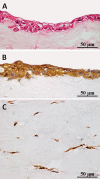Regeneration of Vocal Fold Mucosa Using Tissue-Engineered Structures with Oral Mucosal Cells
- PMID: 26730600
- PMCID: PMC4701435
- DOI: 10.1371/journal.pone.0146151
Regeneration of Vocal Fold Mucosa Using Tissue-Engineered Structures with Oral Mucosal Cells
Abstract
Objectives: Scarred vocal folds result in irregular vibrations during phonation due to stiffness of the vocal fold mucosa. To date, a completely satisfactory corrective procedure has yet to be achieved. We hypothesize that a potential treatment option for this disease is to replace scarred vocal folds with organotypic mucosa. The purpose of this study is to regenerate vocal fold mucosa using a tissue-engineered structure with autologous oral mucosal cells.
Study design: Animal experiment using eight beagles (including three controls).
Methods: A 3 mm by 3 mm specimen of canine oral mucosa was surgically excised and divided into epithelial and subepithelial tissues. Epithelial cells and fibroblasts were isolated and cultured separately. The proliferated epithelial cells were co-cultured on oriented collagen gels containing the proliferated fibroblasts for an additional two weeks. The organotypic cultured tissues were transplanted to the mucosa-deficient vocal folds. Two months after transplantation, vocal fold vibrations and morphological characteristics were observed.
Results: A tissue-engineered vocal fold mucosa, consisting of stratified epithelium and lamina propria, was successfully fabricated to closely resemble the normal layered vocal fold mucosa. Laryngeal stroboscopy revealed regular but slightly small mucosal waves at the transplanted site. Immunohistochemically, stratified epithelium expressed cytokeratin, and the distributed cells in the lamina propria expressed vimentin. Elastic Van Gieson staining revealed a decreased number of elastic fibers in the lamina propria of the transplanted site.
Conclusion: The fabricated mucosa with autologous oral mucosal cells successfully restored the vocal fold mucosa. This reconstruction technique could offer substantial clinical advantages for treating intractable diseases such as scarring of the vocal folds.
Conflict of interest statement
Figures










References
-
- Hirano M. Morphological structure of the vocal cord as a vibrator and its variations. Folia Phoniatr (Basel). 1974;26: 89–94. - PubMed
-
- Kurita S, Nagata K, Hirano M. A comparative study of the layer structure of the vocal fold College-Hill: Vocal fold physiology San Diego; 1983:3–21.
-
- Isshiki N, shoji K, Kojima H, Hirano S. Vocal fold atrophy and its surgical treatment. Ann Otol Rhinol Laryngol. 1996;105: 182–188. - PubMed
-
- Isshiki N. Progress in laryngeal framework surgery. Acta Otolaryngol. 2000;120: 120–127. - PubMed
Publication types
MeSH terms
LinkOut - more resources
Full Text Sources
Other Literature Sources

